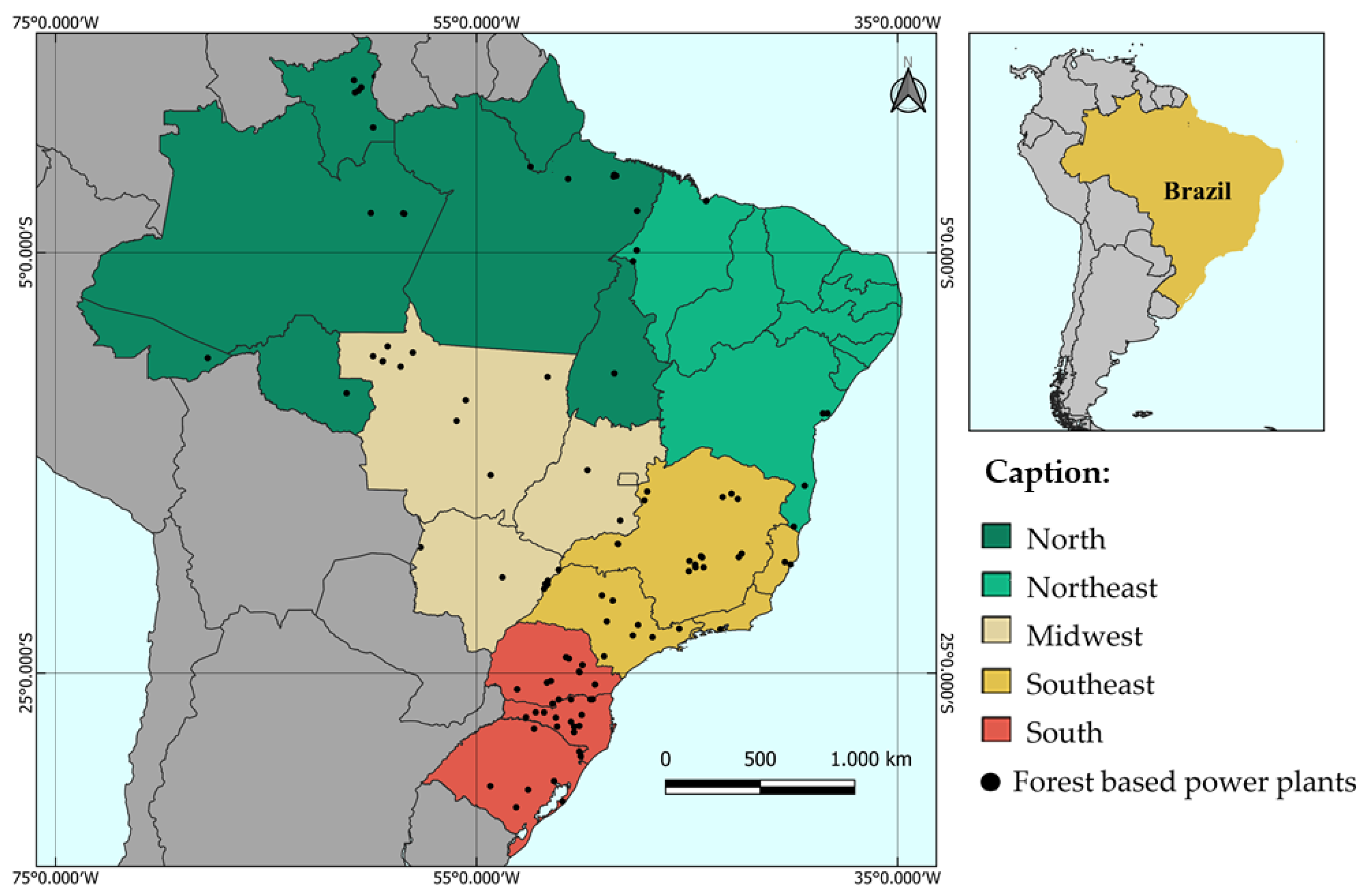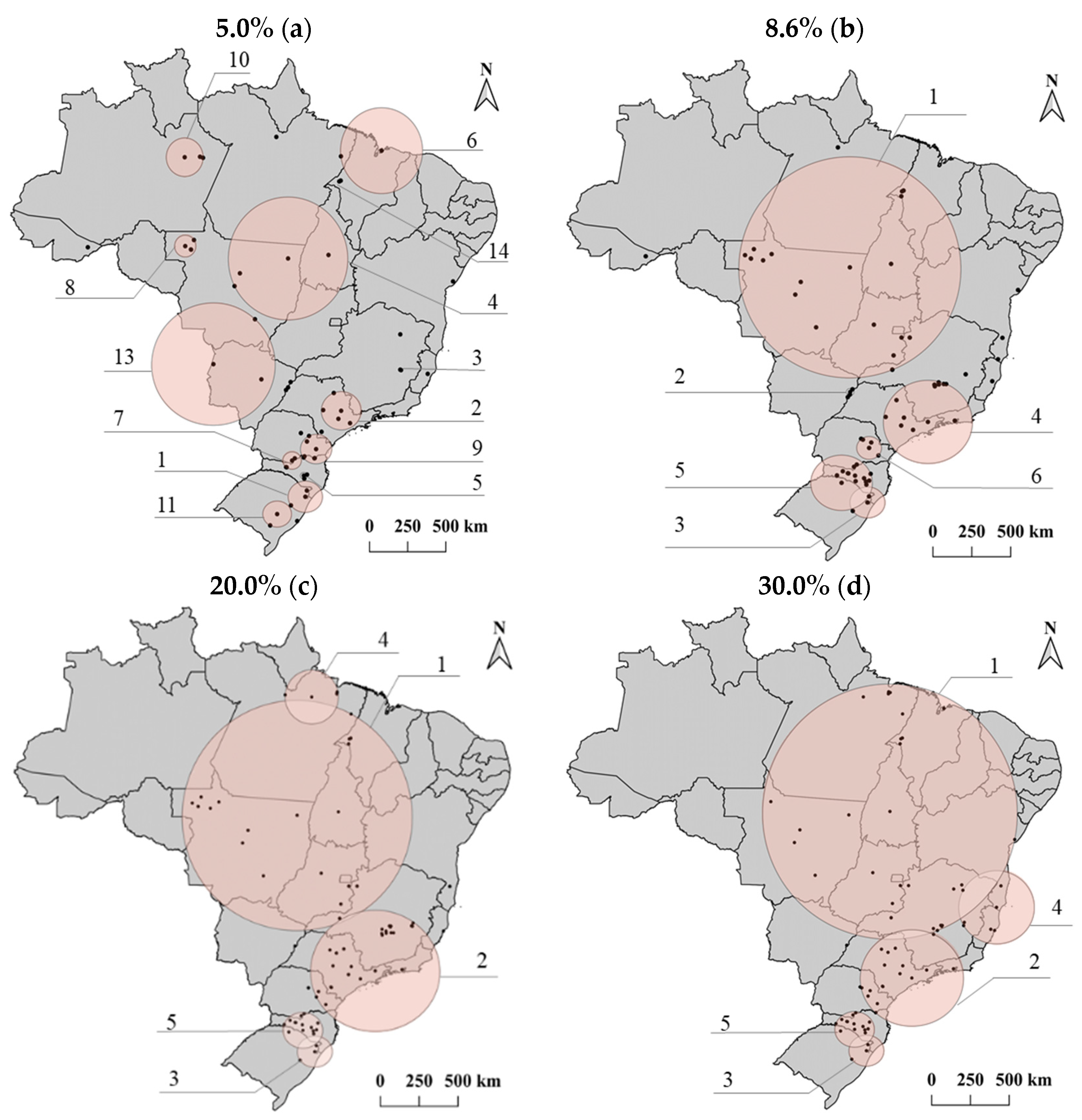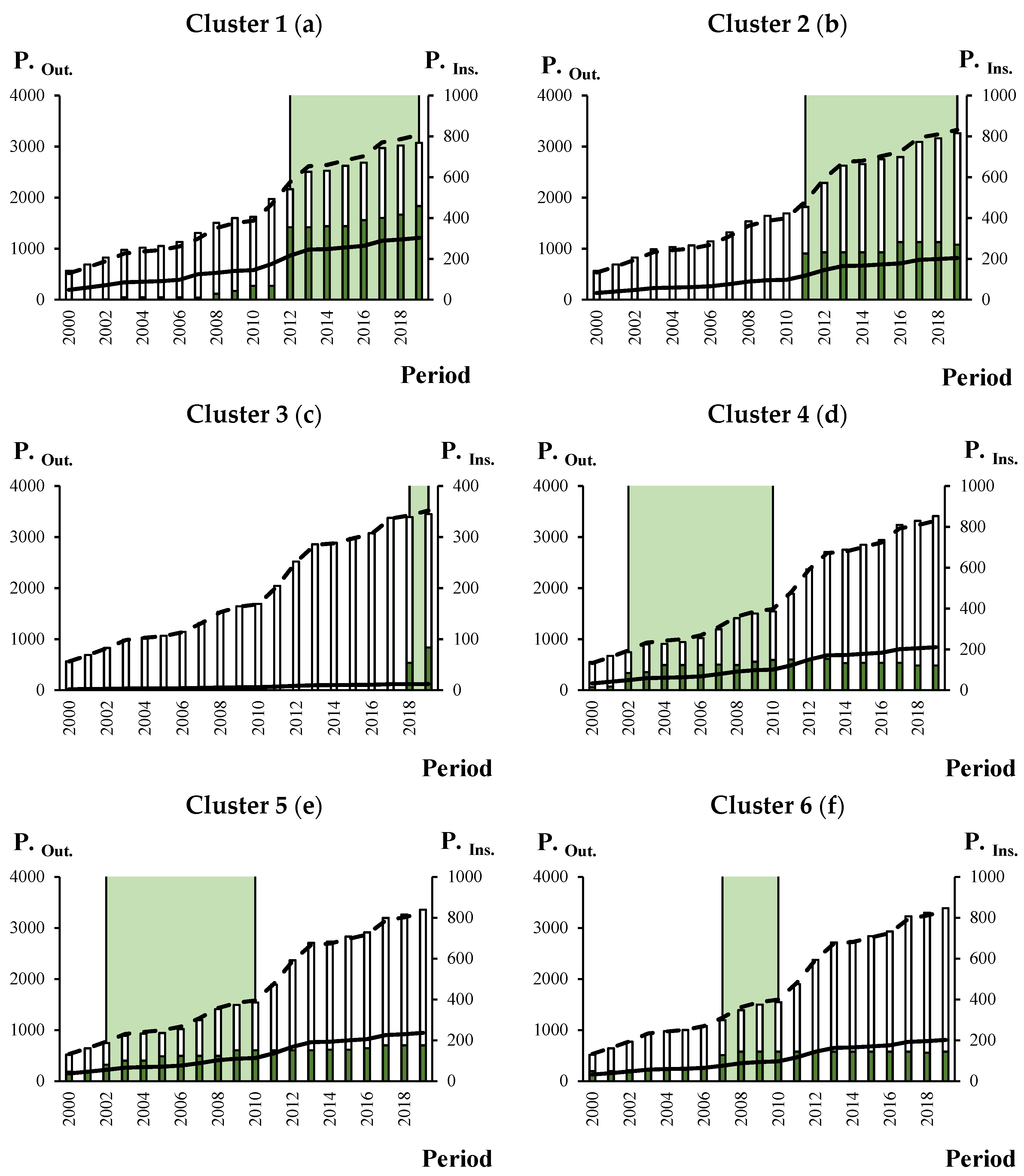Space-Time Conglomerates Analysis of the Forest-Based Power Plants in Brazil (2000–2019)
Abstract
1. Introduction
2. Materials and Methods
2.1. Study Object
2.2. Scan Statistics
3. Results and Discussion
4. Conclusions
Author Contributions
Funding
Institutional Review Board Statement
Informed Consent Statement
Data Availability Statement
Conflicts of Interest
References
- Deboni, T.L.; Simioni, F.J.; Brand, M.A.; Lopes, G.P. Evolution of the quality of forest biomass for energy generation in a cogeneration plant. Renew. Energy 2019, 135, 1291–1302. [Google Scholar] [CrossRef]
- Kilpeläinen, A.; Alam, A.; Torssonen, P.; Ruusuvuori, H.; Kellomäki, S.; Peltola, H. Effects of intensive forest management on net climate impact of energy biomass utilisation from final felling of Norway spruce. Biomass Bioenerg. 2016, 87, 1–8. [Google Scholar] [CrossRef]
- Nunes, L.J.R.; Causer, T.P.; Ciolkosz, D. Biomass for energy: A review on supply chain management models. Renew. Sustain. Energy Rev. 2020, 120, 109658. [Google Scholar] [CrossRef]
- Nishiguchi, S.; Tabata, T. Assessment of social, economic, and environmental aspects of woody biomass energy utilization: Direct burning and wood pellets. Renew. Sustain. Energy Rev. 2016, 57, 1279–1286. [Google Scholar] [CrossRef]
- Acda, M.N.; Devera, E.E. Physico-chemical properties of wood pellets from forest residues. J. Trop. For. Sci. 2014, 26, 589–595. [Google Scholar]
- Evans, A.; Strezov, V.; Evans, T.J. Sustainability considerations for electricity generation from biomass. Renew. Sustain. Energy Rev. 2010, 14, 1419–1427. [Google Scholar] [CrossRef]
- International Energy Agency Statistics Data Browser. 2022. Available online: https://www.iea.org/statistics/ (accessed on 19 March 2022).
- Empresa de Pesquisa Energética. EPE Brazilian Energy Balance 2019 Year 2018; EPE—Empresa Pesquisa Energética: Rio de Janeiro, Brazil, 2019; 297p. [Google Scholar]
- Coelho Junior, L.M.; Martins, K.L.C.; Carvalho, M. Carbon Footprint Associated with Firewood Consumption in Northeast Brazil: An Analysis by the IPCC 2013 GWP 100y Criterion. Waste Biomass Valoriz. 2019, 10, 2985–2993. [Google Scholar] [CrossRef]
- Jin, E.; Sutherland, J.W. An integrated sustainability model for a bioenergy system: Forest residues for electricity generation. Biomass Bioenerg. 2018, 119, 10–21. [Google Scholar] [CrossRef]
- Food and Agriculture Organization of the United Nations Wood Energy. Available online: https://www.fao.org/forestry/energy/en/ (accessed on 19 March 2022).
- Da Costa Martins, K.D.L.; Melquíades, T.F.; de Rezende, J.L.P.; Coelho Junior, L.M. Plant Extractivism Production Disparity Between Northeast Brazil and Brazil. Floresta Ambient. 2018, 25, e20160456. [Google Scholar] [CrossRef]
- Marshall, A. Princípios de Economia; Nova Cultura: Sao Paulo, Brazil, 1984. [Google Scholar]
- Porter, M.E. Location, Competition, and Economic Development: Local Clusters in a Global Economy. Econ. Dev. Q. 2000, 14, 15–34. [Google Scholar] [CrossRef]
- Porter, M.E. Clusters and the new economics of competition. Harv. Bus. Rev. 1998, 76, 77–90. [Google Scholar] [PubMed]
- Capello, R. Regional Economics; Routledge: London, UK, 2015; ISBN 9781138855885. [Google Scholar]
- Pereira, M.G.; Caramelo, L.; Orozco, C.V.; Costa, R.; Tonini, M. Space-time clustering analysis performance of an aggregated dataset: The case of wildfires in Portugal. Environ. Model. Softw. 2015, 72, 239–249. [Google Scholar] [CrossRef]
- Kulldorff, M. A spatial scan statistic. Commun. Stat. Theory Methods 1997, 26, 1481–1496. [Google Scholar] [CrossRef]
- Arroyo, L.H.; Yamamura, M.; Protti-Zanatta, S.T.; Fusco, A.P.B.; Palha, P.F.; Ramos, A.C.V.; Uchoa, S.A.; Arcêncio, R.A. Identificação de áreas de risco para a transmissão da tuberculose no município de São Carlos, São Paulo, 2008 a 2013. Epidemiol. Serviços Saúde 2017, 26, 525–534. [Google Scholar] [CrossRef]
- Lieu, T.A.; Ray, G.T.; Klein, N.P.; Chung, C.; Kulldorff, M. Geographic Clusters in Underimmunization and Vaccine Refusal. Pediatrics 2015, 135, 280–289. [Google Scholar] [CrossRef]
- Nigatu, A.M.; Gelaye, K.A.; Degefie, D.T.; Birhanu, A.Y. Spatial variations of women’s home delivery after antenatal care visits at lay Gayint District, Northwest Ethiopia. BMC Public Health 2019, 19, 677. [Google Scholar] [CrossRef]
- Randolph, K.D. Using satscan spatial-scan software with national forest inventory data: A case study in South Carolina. Math. Comput. For. Nat. Sci. 2017, 9, 1–13. [Google Scholar]
- Vega Orozco, C.; Tonini, M.; Conedera, M.; Kanveski, M. Cluster recognition in spatial-temporal sequences: The case of forest fires. Geoinformatica 2012, 16, 653–673. [Google Scholar] [CrossRef]
- Shekede, M.D.; Mupandira, I.; Gwitira, I. Spatio-temporal clustering of active wildfire pixels over a 19-year period in a southern African savanna ecosystem of Zimbabwe. S. Afr. Geogr. J. 2020, 103, 283–302. [Google Scholar] [CrossRef]
- Coelho Junior, L.M.; Santos Junior, E.P.; Nunes, A.M.M.; Simioni, F.J.; Abrahao, R.; Junior, P.R. Concentration and Spatial Clustering of Forest-Based Thermoelectric Plants in Brazil. IEEE Access 2020, 8, 221932–221941. [Google Scholar] [CrossRef]
- Coelho Junior, L.M.; Santos Junior, E.P.; Nunes, A.M.M.; de Souza, A.N.; Borges, L.A.C.; Simioni, F.J. Concentration and Clusters of Black Liquor Thermoelectric Plants in Brazil. IEEE Lat. Am. Trans. 2021, 19, 2122–2129. [Google Scholar] [CrossRef]
- Agência Nacional de Energia Elétrica. Sistema de Informações de Geração da ANEEL. 2020. Available online: http://www2.aneel.gov.br/aplicacoes/capacidadebrasil/OperacaoCapacidadeBrasil.cfm (accessed on 5 September 2020).
- Instituto Brasileiro de Geografia e Estatística. Malhas Territoriais. 2022. Available online: https://www.ibge.gov.br/geociencias/organizacao-do-territorio/malhas-territoriais.html (accessed on 1 April 2022).
- Kulldorff, M. SaTScanTM user guide for version 9.4. J. Geogr. Inf. Syst. 2015, 13, 116. [Google Scholar]
- Kulldorff, M.; Heffernan, R.; Hartman, J.; Assunção, R.; Mostashari, F. A Space-Time Permutation Scan Statistic for Disease Outbreak Detection. PLoS Med. 2005, 2, e59. [Google Scholar] [CrossRef] [PubMed]
- Dwass, M. Modified Randomization Tests for Nonparametric Hypotheses. Ann. Math. Stat. 1957, 28, 181–187. [Google Scholar] [CrossRef]
- Cuenca, G.M.A.; Dompieri, M.H.G. Dinâmica espacial da canavicultura e análise dos efeitos sobre o valor bruto da produção, na região dos tabuleiros costeiros da Paraíba, Pernambuco e Alagoas. Rev. Econômica Do Nordeste 2016, 47, 91–106. [Google Scholar]
- Bichel, A.; Telles, T.S. Spatial dynamics of firewood and charcoal production in Brazil. J. Clean. Prod. 2021, 313, 127714. [Google Scholar] [CrossRef]
- Simioni, F.J.; Moreira, J.M.M.Á.P.; Fachinello, A.L.; Buschinelli, C.C.D.A.; da Matsuura, M.I.S.F. Evolução e concentração da produção de lenha e carvão vegetal da silvicultura no Brasil. Ciência Florest. 2017, 27, 731–742. [Google Scholar] [CrossRef]
- De Oliveira, L.L.; de Oliveira Ribeiro, C.; Qadrdan, M. Analysis of electricity supply and demand intra-annual dynamics in Brazil: A multi-period and multi-regional generation expansion planning model. Int. J. Electr. Power Energy Syst. 2022, 137, 107886. [Google Scholar] [CrossRef]
- Brasil Plano Decenal de Expansão de Energia 2027, Brasília. 2018. Available online: http://antigo.mme.gov.br/web/guest/secretarias/planejamento-e-desenvolvimento-energetico/publicacoes/plano-decenal-de-expansao-de-energia (accessed on 2 April 2022).
- Dufourny, A.; Van De Steene, L.; Humbert, G.; Guibal, D.; Martin, L.; Blin, J. Influence of pyrolysis conditions and the nature of the wood on the quality of charcoal as a reducing agent. J. Anal. Appl. Pyrolysis 2019, 137, 1–13. [Google Scholar] [CrossRef]
- Da Silva, R.R.; de CarvalhoMathias, F.R.; Bajay, S.V. Potential energy efficiency improvements for the Brazilian iron and steel industry: Fuel and electricity conservation supply curves for integrated steel mills. Energy 2018, 153, 816–824. [Google Scholar] [CrossRef]
- Broughel, A.E. Impact of state policies on generating capacity for production of electricity and combined heat and power from forest biomass in the United States. Renew. Energy 2019, 134, 1163–1172. [Google Scholar] [CrossRef]
- Angelo, H.; da Silva, G.F.; Moraes, V.F. Análise econômica da indústria de madeiras tropicais: O caso do pólo de Sinop, MT. Ciência Florest. 2004, 14, 91. [Google Scholar] [CrossRef][Green Version]
- De Souza, J.R.F.; Pietrafesa, P.A. A nova indústria do sudoeste maranhense: Impactos socioeconômicos na cidade de Imperatriz—MA. Desenvolv. Reg. Debate 2019, 9, 143–155. [Google Scholar]
- Furtado, T.S.; Ferreira, J.C.; Brand, M.A.; de Muñiz, G.I.B.; Quirino, W.F. Mapeamento da frequência de uso e características da biomassa florestal utilizada para geração de energia em Lages, SC. Ciência Florest. 2012, 22, 795–802. [Google Scholar] [CrossRef]
- De Almeida, A.N.; da Silva, J.C.G.L.; Angelo, H. Influência da Klabin no mercado de madeira em tora do estado do Paraná. Cerne 2012, 18, 153–158. [Google Scholar] [CrossRef][Green Version]
- Da Silva, R.C.; de Marchi Neto, I.; Seifert, S.S. Electricity supply security and the future role of renewable energy sources in Brazil. Renew. Sustain. Energy Rev. 2016, 59, 328–341. [Google Scholar] [CrossRef]
- De Melo, C.A.; de MartinoJannuzzi, G.; Bajay, S.V. Nonconventional renewable energy governance in Brazil: Lessons to learn from the German experience. Renew. Sustain. Energy Rev. 2016, 61, 222–234. [Google Scholar] [CrossRef]
- Tolmasquim, M.T.; de Barros Correia, T.; Addas Porto, N.; Kruger, W. Electricity market design and renewable energy auctions: The case of Brazil. Energy Policy 2021, 158, 112558. [Google Scholar] [CrossRef]
- Mercure, J.-F.; Paim, M.A.; Bocquillon, P.; Lindner, S.; Salas, P.; Martinelli, P.; Berchin, I.I.; de Andrade Guerra, J.B.S.; Derani, C.; de Albuquerque Junior, C.L.; et al. System complexity and policy integration challenges: The Brazilian Energy-Water-Food Nexus. Renew. Sustain. Energy Rev. 2019, 105, 230–243. [Google Scholar] [CrossRef]


 Pot. expected inside the cluster,
Pot. expected inside the cluster,  Pot. expected outside the cluster,
Pot. expected outside the cluster,  Pot. observed inside the cluster,
Pot. observed inside the cluster,  Pot. observed outside the cluster,
Pot. observed outside the cluster,  Cluster.
Cluster.
 Pot. expected inside the cluster,
Pot. expected inside the cluster,  Pot. expected outside the cluster,
Pot. expected outside the cluster,  Pot. observed inside the cluster,
Pot. observed inside the cluster,  Pot. observed outside the cluster,
Pot. observed outside the cluster,  Cluster.
Cluster.
| C. | Centroid | R (km) | LRG | Obs.Avg. | Exp.Avg. | Time | p-Value |
|---|---|---|---|---|---|---|---|
| 1 | Porto Alegre do N.-MT | 957.48 | 211,586.11 | 386.92 | 264.37 | 2012–2019 | <0.001 |
| 2 | Três Lagoas—MS | 30.60 | 154,784.35 | 252.23 | 171.82 | 2011–2019 | <0.001 |
| 3 | Cambará do Sul—RS | 134.23 | 124,508.28 | 68.70 | 12.21 | 2018–2019 | <0.001 |
| 4 | Pindamonhangaba—SP | 360.24 | 106,219.37 | 119.91 | 74.66 | 2002–2010 | <0.001 |
| 5 | Erechim—RS | 239.66 | 63,438.13 | 119.66 | 83.50 | 2002–2010 | <0.001 |
| 6 | Carambeí-PR | 98.74 | 51,839.53 | 140.00 | 88.31 | 2007–2010 | <0.001 |
| C. | Termelétrica | County | LRG | Obs.Avg. | Exp.Avg. | Time | p-Value |
|---|---|---|---|---|---|---|---|
| 1 | Fibria—MS II | Três Lagoas-MS | 486,909.02 | 269,580.00 | 71,110.79 | 2017–2019 | <0.001 |
| 2 | Klabin Celulose | Ortigueira-PR | 327,648.46 | 330,000.00 | 186,411.81 | 2013–2019 | <0.001 |
| 3 | Cenibra | Belo Oriente-MG | 167,727.27 | 100,000.00 | 48,658.05 | 2000–2007 | <0.001 |
| 3 | Veracel | Eunápolis-BA | 128,345.16 | 121,822.50 | 69,882.34 | 2003–2010 | <0.001 |
| 4 | Jari Celulose | Almeirim-PA | 91,706.31 | 55,000.00 | 26,761.93 | 2000–2007 | <0.001 |
| 5 | Bahia Pulp | Camaçari-BA | 67,399.03 | 108,600.00 | 63,262.77 | 2007–2011 | <0.001 |
| 6 | Suzano Mucuri | Mucuri-BA | 37,517.02 | 92,000.00 | 52,059.60 | 2000–2002 | <0.001 |
| 7 | Triunfo | Rio Branco-AC | 35,093.90 | 28,970.00 | 14,251.90 | 2014–2019 | <0.001 |
| 8 | João Neiva | João Neiva-ES | 4229.26 | 3500.00 | 1721.84 | 2014–2019 | <0.001 |
Publisher’s Note: MDPI stays neutral with regard to jurisdictional claims in published maps and institutional affiliations. |
© 2022 by the authors. Licensee MDPI, Basel, Switzerland. This article is an open access article distributed under the terms and conditions of the Creative Commons Attribution (CC BY) license (https://creativecommons.org/licenses/by/4.0/).
Share and Cite
Coelho Junior, L.M.; Santos Júnior, E.P. Space-Time Conglomerates Analysis of the Forest-Based Power Plants in Brazil (2000–2019). Energies 2022, 15, 4113. https://doi.org/10.3390/en15114113
Coelho Junior LM, Santos Júnior EP. Space-Time Conglomerates Analysis of the Forest-Based Power Plants in Brazil (2000–2019). Energies. 2022; 15(11):4113. https://doi.org/10.3390/en15114113
Chicago/Turabian StyleCoelho Junior, Luiz Moreira, and Edvaldo Pereira Santos Júnior. 2022. "Space-Time Conglomerates Analysis of the Forest-Based Power Plants in Brazil (2000–2019)" Energies 15, no. 11: 4113. https://doi.org/10.3390/en15114113
APA StyleCoelho Junior, L. M., & Santos Júnior, E. P. (2022). Space-Time Conglomerates Analysis of the Forest-Based Power Plants in Brazil (2000–2019). Energies, 15(11), 4113. https://doi.org/10.3390/en15114113






